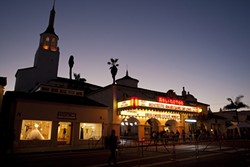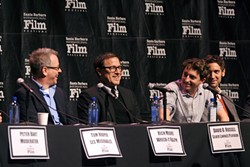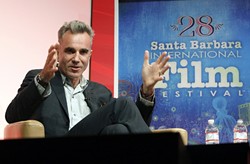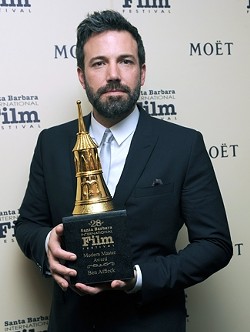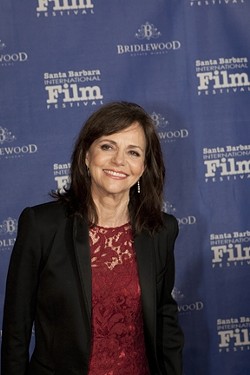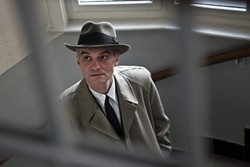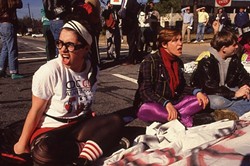Everything is illuminated
One writer's look into the people and films that made a difference at the Santa Barbara International Film Festival
By Anna Weltner[{
"name": "Ad - Medium Rectangle CC01 - 300x250",
"id": "AdMediumRectangleCC01300x250",
"class": "inlineCenter",
"insertPoint": "8",
"component": "2963441",
"requiredCountToDisplay": "12"
},{
"name": "Ad - Medium Rectangle LC01 - 300x250",
"id": "AdMediumRectangleCC01300x250",
"class": "inlineCenter",
"insertPoint": "18",
"component": "2963441",
"requiredCountToDisplay": "22"
},{
"name": "Ad - Medium Rectangle LC09 - 300x250",
"id": "AdMediumRectangleLC09300x250",
"class": "inlineCenter",
"insertPoint": "28",
"component": "3252660",
"requiredCountToDisplay": "32"
}]
Throughout the past year, many of the most successful films have seemed especially concerned, each in its own way, with justice. Spielberg’s Lincoln is, of course, an obvious example—the masterful telling of how slavery was abolished. But at the movies, justice can also be served retroactively in a show of flamboyant ultraviolence, as in Tarantino’s revenge fantasy (which, to be fair, has been his thing for a while) Django Unchained. Others, such as Ben Affleck’s Argo and Kathryn Bigelow’s Zero Dark Thirty, concerned themselves with brave individuals whose actions might otherwise have been overlooked by history.
When I made a yearly pilgrimage to the Santa Barbara International Film Festival—where, incidentally, Day-Lewis, Affleck, and Tarantino received awards—this trend seemed to continue. I realized, on the journey home, that the weekend’s strongest films seemed also to orient themselves around social justice, historical illumination, or some combination of the two. Here are a few to look out for.
Angels in Exile
Filmmaker Billy Raftery took a surfing trip to South Africa and came back with a raw, character-driven portrait of Durban’s street children.
Angels in Exile, which saw its world premiere on Friday, Jan. 25, is about as crushingly honest as a documentary gets. Narrated by South Africa native Charlize Theron, Angels follows homeless teenagers Zuleika and Ariel to adulthood, and—at least where the film concludes—stability.
The film depicts a street culture in which rape, drug abuse, and violence are everyday occurrences. And so the hardest thing for a Westerner to understand may be that kids like Ariel and Zuleika seem to prefer the street to their family homes, where, in so many cases, they have been regularly subjected to physical, mental, or sexual abuse. On the street, in contrast, there can be found a twisted kind of independence and camaraderie—and, of course, no shortage of glue, which homeless children are depicted huffing out of plastic bottles, eyes glazed.
We are introduced to this gutter of the world—located, with cruel irony, in a place of overwhelming natural splendor—through the outspoken Zuleika, then 12 years old. A horrific childhood, in which Zuleika was raped by her father and infected with HIV, is not at first apparent in her cheerful, confident attitude. Yet as the camera follows her to her sister’s home, we begin to understand more of her history.
The film’s stark depictions of human misery, captured over a period of eight years, stand in contrast to its director, a friendly, youthful surfer whom I met following the film’s premiere.
“She was the most interesting girl that I had come across, in terms of just her charisma, how confident she was in just approaching me, you know, like ‘Hey white boy, what are you doing here?’” Raftery said of Zuleika. “Normally the girls are very standoffish, because when they see anybody that’s white or a foreigner … they instantly think they’ll be targets of sexual abuse or something like that, so they kind of categorize outsiders in that way. So for her to be so brazen and just come up, I was like, this is incredible.”
Running parallel to Zuleika’s story is that of Ariel, a boy from an Indian family who has taken to the streets to flee an abusive uncle.
“He was my first buddy,” Raftery said, “because he spoke fluent English, as an Indian kid, and hung out with all these Zulu kids … and that eventually led me to Zuleika.”
After his father suffered a stroke, Ariel explains, the man was no longer able to protect him from his violent uncle, so he left. These days, Ariel wants to get off the street but is now powerfully addicted to glue, a substance he seems to both crave and deeply resent. When a social worker offers to take him to a rehab clinic, Ariel rides with him all the way to the front door, then changes his mind, saying the clinic is too close to the city, and he knows he’ll just run away and go back to using glue.
The viewer’s frustration at these children’s seeming unwillingness to “help themselves” only grows throughout the film, and we begin to experience some of what social workers must experience every day: a surge of hope-against-hope as these children earnestly express the desire to change their lives, followed swiftly by crushing disappointment as we watch them return to the street, turning, in Ariel’s case, to running drugs, an in Zuleika’s, to prostitution as well.
Tom and Mandi Hewitt, social workers and co-founders of the advocacy group Umthombo Street Children, help reach out to these children, granting filmmaker Raftery far more access than he might have otherwise had. Mandi, a former street kid herself, constantly entreats a stubborn Zuleika to stay at her sister’s, which proves even more difficult when Zuleika’s sister, JT, is less than welcoming.
Mandi, too, has a story. She takes the viewer on a tour of her former home, located among municipal garbage dumps, her family’s source of food when she was a child.
Raftery’s documentary, however, is much more than the pity-mongering it could easily have been, placing serious emphasis on the problems that lead to child homelessness in the first place: poverty, abusive homes, parents lost to AIDS. It also clearly shows how current tactics enforced by city police—namely, the violent and routine rounding up of Durban’s unsightly homeless, depositing them out in the countryside—simply aren’t working.
In the Shadow (Ve Stinu)
From its opening scene, director David Ondˇríˇcek’s In the Shadow is quintessential noir. It’s bleak. It’s gray. Detectives turn trench coat collars up against the pouring rain before slinking into dark alleys and disappearing from sight, save for the moody glow of a lone cigarette.
But for all its ’50s noir stylishness, for which we also have Polish cinematographer Adam Sikora to thank, Ondˇríˇcek’s stellar crime film feels remarkably contemporary, with all of the iconography and yet none of the naïveté (read: cheesiness) of the great classics of the genre.
Set in Prague in 1953, In the Shadow follows Captain Hakl (played by Ivan Trojan), an honest police detective investigating a jewelry store hiest. In the hands of a corrupt secret police, however, this rather mundane crime is turned into a political scandal.
Hakl is taken off the case and is replaced by an East German police specialist, Major Zenke (Sebastian Koch). Zenke and his officers determine that the jewels were stolen by Jews to finance “Zionist terrorism,” yet Hakl’s instincts tell him otherwise. He begins his own clandestine investigation and follows a trail that leads him into the heart of government corruption.
In the Shadow, which was the Czech Republic’s official Oscar entry for Best Foreign Language Film, draws historical inspiration from the Stalin-instigated show trials of the era, aimed at purging “disloyal” members of the Communist Party of Czechoslovakia, particularly Jews. On screen, this dark historical setting, combined with the backdrop of gorgeous yet gloomy-looking Prague, generates an atmosphere of general uncertainty and dread.
Trojan, known for his work in the theater as well as on screen, delivers a mature and wonderfully layered performance. Lean and wary-eyed, Hekl appears the hardened criminologist, stoic in the face of the violence and death his work involves. His obsession with his work, and his inability to share much of the details, makes him occasionally seem cold and aloof toward his wife, Jitka (Soˇna Norisová). (With his young son, however, Hekl is tender and attentive, as if trying to build around him a safer world than the one he himself inhabits.) In perhaps a deliberately oblique touch, Hekl spends his nights while he’s on the case sleeping in a livingroom armchair, “so I don’t wake you up.” Until much later in the film, it’s hard to tell whether this is an expression of marital disatisfaction or, indeed, simply a courtesy from a husband working odd hours.
The seeds of uncertainty are nonetheless planted, and when Zenke moves into the same apartment building as the Hekl family, tension steadily builds. A scene in the laundry room between Jitka and her husband’s East German rival carries undertones of forbidden desire, of nervous possibility, yet somehow without ever leaving the realm of acceptible interaction. Nevertheless, when a neighbor enters the room, the two instantly appear guilty.
Koch, who was brilliant in the Oscar-winning German drama The Lives of Others (incidentally, also a secret police movie), brings a measure of warmth and humanity to a role that seems to exist in a kind of moral gray area. Zenke himself isn’t a villian. His orders come from above, and he initially protests. But ultimately, in his silence, he is complicit in the killing of innocents—and not only those he’s implicated in the jewel theft turned act of Zionist terrorism. This thing isn’t going to end well.
How to Survive a Plague
I’ll try not to spend too much ink raving about David France’s smart, powerful, and incredibly human documentary, as it’s already come and gone in our area (the film played at the Palm for about a minute). But for those who didn’t get a chance to see the Oscar-nominated How to Survive a Plague, an intimate look into the work of AIDS activist groups Act Up and TAG (Treatment Action Group), listen up.
How to Survive a Plague takes the viewer into Greenwich Village at the height of the AIDS epidemic, when it was still much maligned as a “gay” disease, to the point where even hospitals turned away the dying. In the ’80s, long before the drugs had been discovered to help people live with AIDS, a community of the infected banded together to educate themselves, support one another, and to demonstrate against the political, social, medical, and religious forces weilding immense power over their lives and their futures.
What’s wonderful about the film, among many things, is its refreshing honesty, showing the foibles and quirks of the people involved in the AIDS activist movement just as readily as its greatest triumphs. In fact, it’s these touches of humanity, of bravado, of sporadic ridiculousness (as when an activist dressed as Jesus, participating in a demonstration against the Catholic Church following the Pope’s condemnation of condoms, explains he’s “JC here, with Fire and Brimstone News,” while in the background a giant, blown-up condom is carried aloft). The individuals of the early AIDS community are depicted as the artistic, irreverant, vibrant beings they were, and watching their members’ slow decline into death feels maddening and wrong.
The life of now-deceased activist Bob Rafsky, who got into a shouting match with then-presidential candidate Bill Clinton (and was on the receiving end of Clinton’s now-infamous “I feel your pain” quote) is illuminated through archival footage of Rafsky’s life as a father and a tireless fighter.
At 120 minuties, How to Survive a Plague is incredidibly comprehensive yet never dull. What’s more, you can stream it on Netflix now, so there’s no reason not to check it out.
No
What with its archival footage, grainy ’80s aesthetic, and unblinking wide shots, director Pablo Larrain’s look at Chile under Augusto Pinochet feels very much like a documentary. Starring Mexican actor Gael García Bernal (of The Motorcycle Diaries and The Science of Sleep), No follows advertising creative René Saavedra, who is leading the campaign to defeat Pinochet in Chile’s 1988 referendum, in which voters determined whether the dictator should extend his rule by another eight years. A 1980 referendum had, rather mysteriously, won by a landslide, thus approving a new constitution that legalized Pinochet’s 17-year presidency.
Many members of the “no” campaign want to emphasize grave realities, such as the government’s killing and torture of political opponents, hoping to frighten the population into voting “no.” But René—who is first seen pitching a TV commercial featuring a rock star crooning lustily about a soda brand to his ecstatic, rapturous fans—can see that graphic images and frightening statistics don’t sell. The Chilean people don’t want to be traumatized anymore, he argues, they want to be happy. So, at a time when the use of advertising language in a political campaign must still have seemed risky, or just plain ridiculous, René designs a campaign that is funny, irreverent, hip, and, most of all, deliriously happy. The kind of transcendent happiness known to soccer fans whose team has won the World Cup. People celebrating in the streets. Dancers. Families eating in the sunshine. Saucy women singing no mi gusta, no with oh-no-he-didn’t swagger. Overnight, the “no” campaign became a kind of irreverent, sexy brand, and the word itself a cry of confidence and empowerment.
Even within the campaign, this happiness tactic, with its giddy rainbow logo, is criticized as foolish and silly. The tall, fair, beautiful people in the ads are criticized for not representing the majority of Chileans. And yet the approach seems to give a repressed people newfound hope and energy, and they begin adopting the campaign’s anthemic, slow-clap-ready chorus Chile, la alegria ya viene (Chile, happiness is coming).
No is the first Chilean film to be nominated for an Oscar, and it isn’t hard to see why. Lorrain’s documentary style, the film’s dry wit, the ’80s propaganda clips made funnier through not having aged very well (and even funnier in their awkward English translations)—it’s all pure gold. But what really grounds the film is García Bernal’s turn as the brave and stubbornly optimistic René. García Bernal projects just the right kind of naïveté, a kind of non-jaded belief in one’s cause and in the goodness of people. We are also witness to the more personal narrative of René’s family life, of his young son Simón (Pascal Montero) and his estranged wife Véronica (Antonia Zegers), with whom he is clearly still very much in love. When the family is threatened as a result of René’s involvement in the “No” campaign, he appears shaken but still determined. Ironically, upon the film’s final victory—which I assume is no spoiler—as the streets swarm with celebrants waving the flags his campaign designed and chanting the slogans he wrote, a realistic incarnation of his idyllic commercials, René’s face only registers a kind of blank, unfeeling disbelief. He walks through the streets, face eventually softening into an expression of relief, a gradual decompression. Only as they begin to melt away do we see the layers of fear and uncertainty within the man who sold the country happiness. ∆
Arts Editor Anna Weltner can be reached at [email protected].
Latest in News
Readers also liked…
-

Coast Unified teachers upset over new position's salary and qualifications
Oct 20, 2022 -

SLO police identify alleged driver who hit and killed couple
Dec 22, 2022 -

When the levee breaks: Oceano residents, county officials walk a tightrope of regulations to manage Arroyo Grande Creek, which some say led to the levee's failure in January
May 18, 2023

